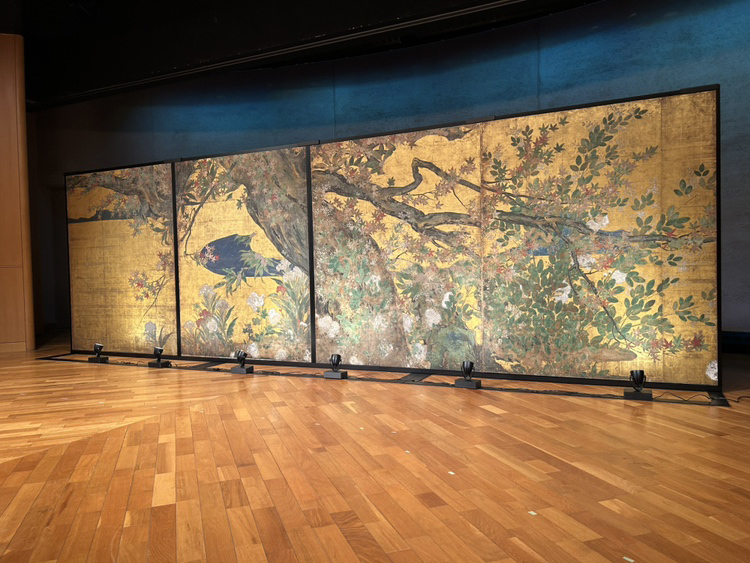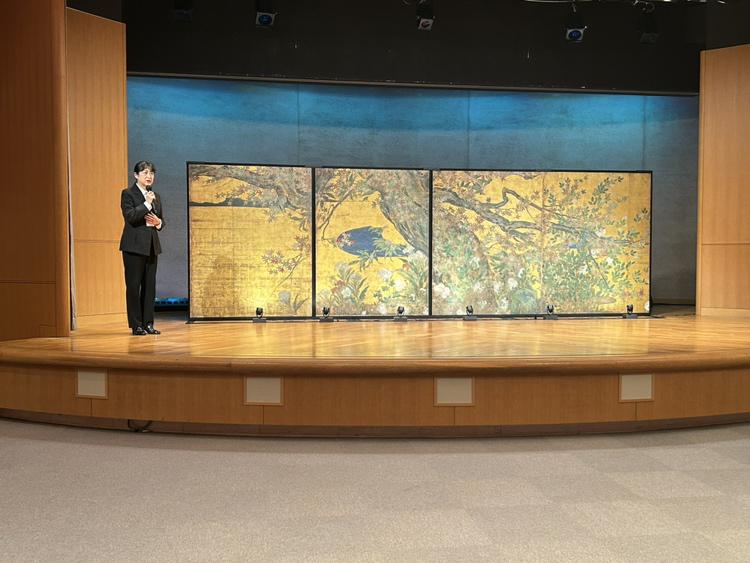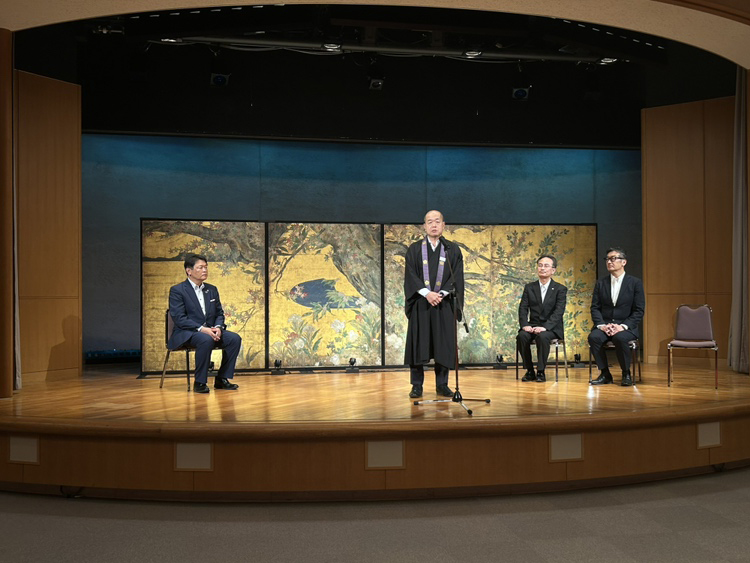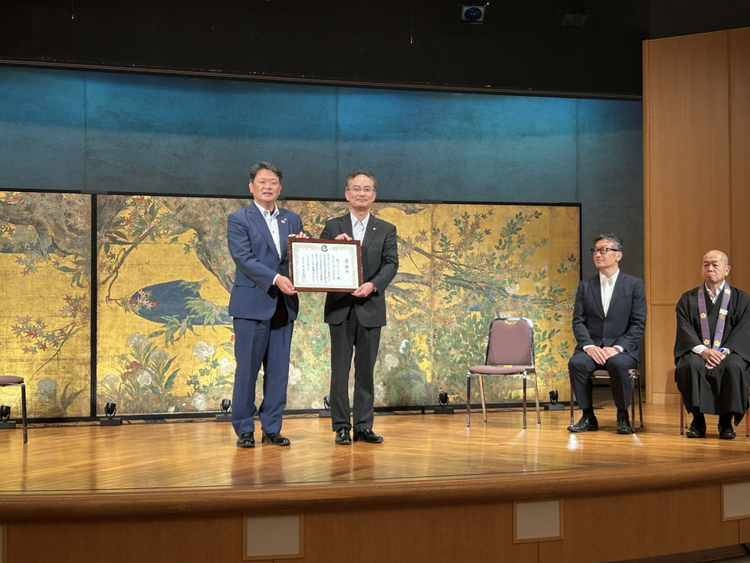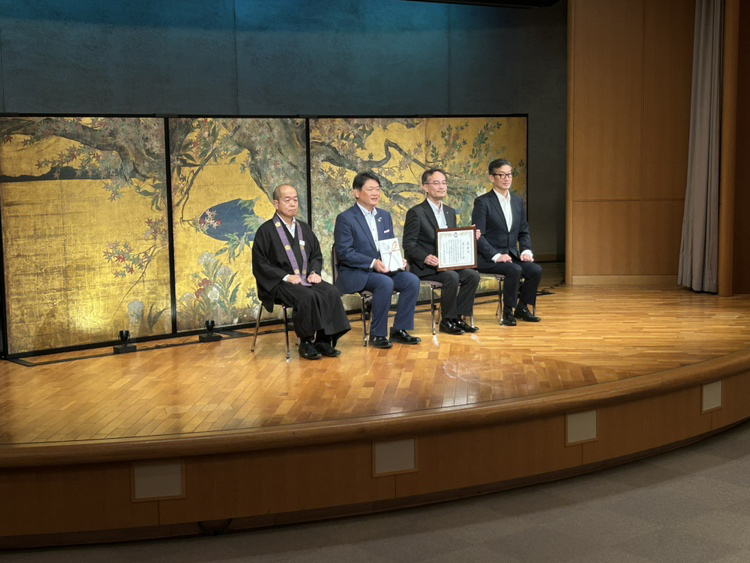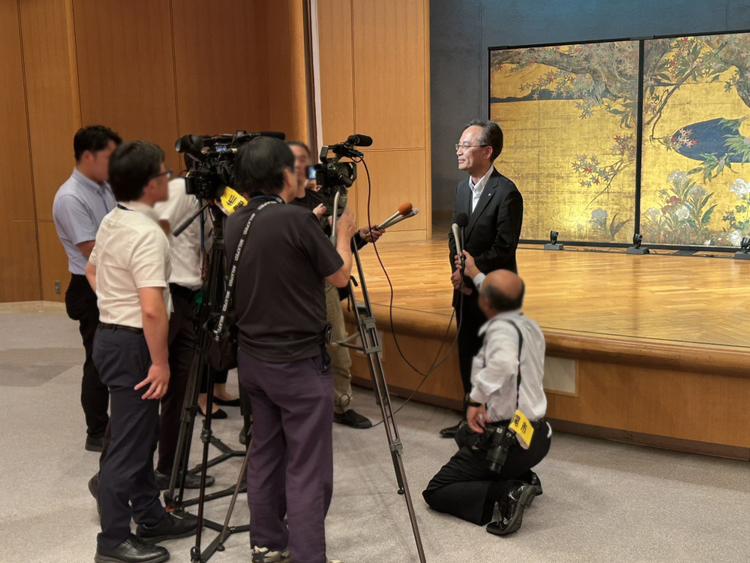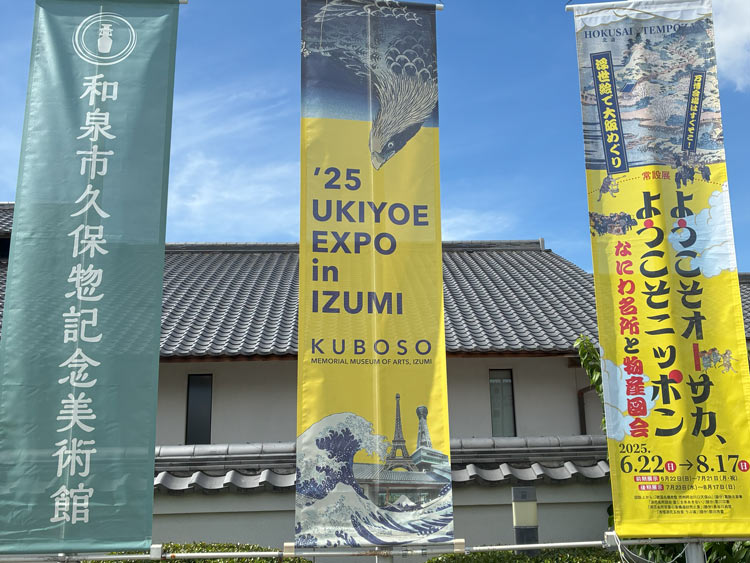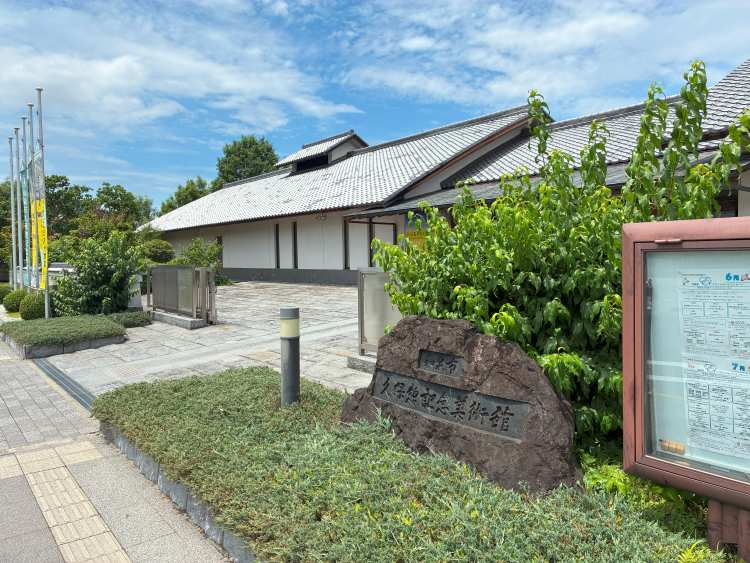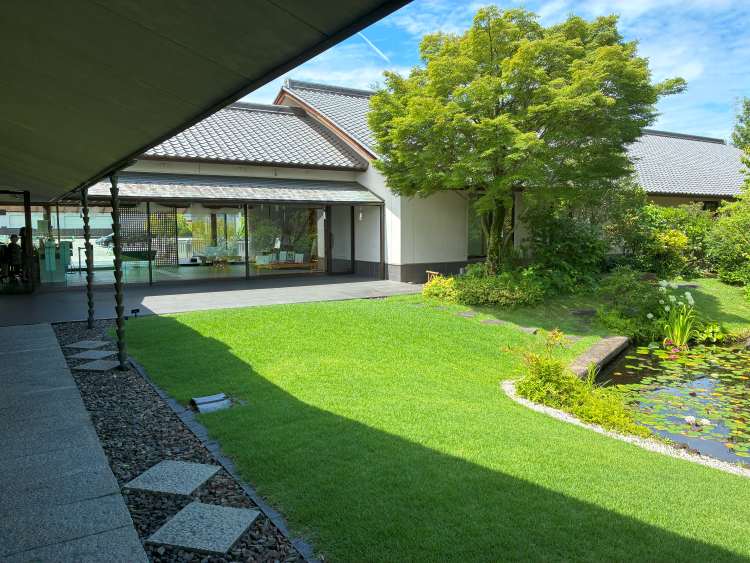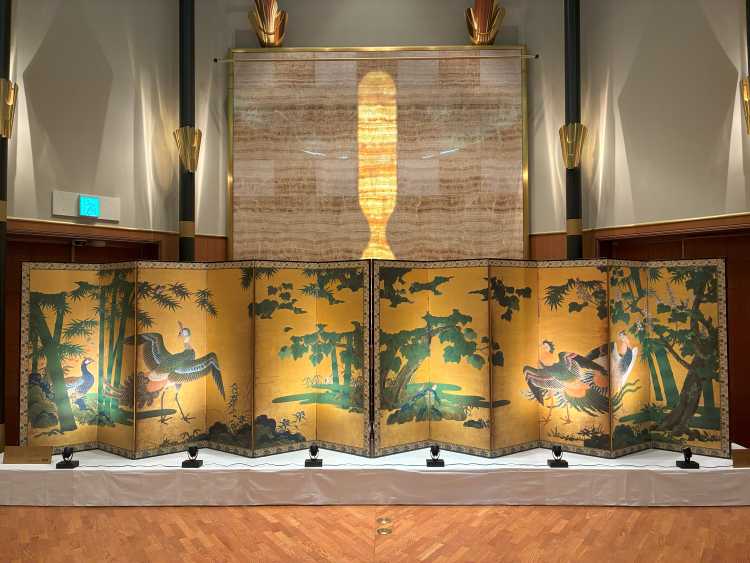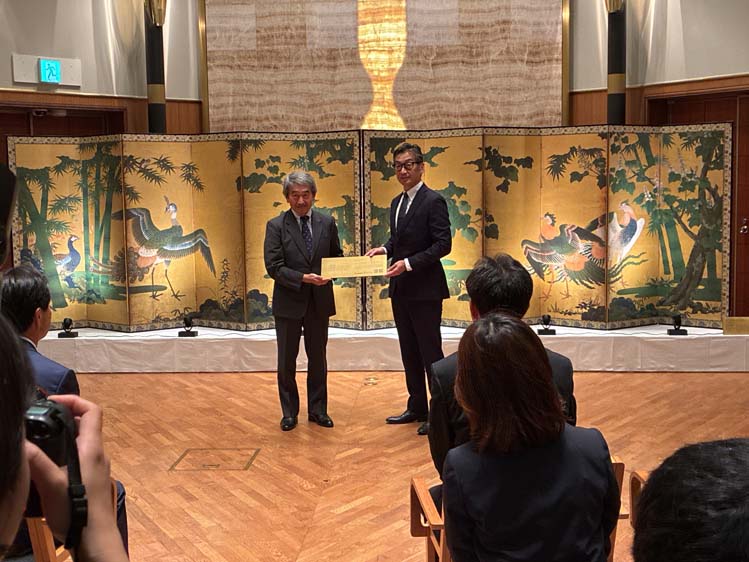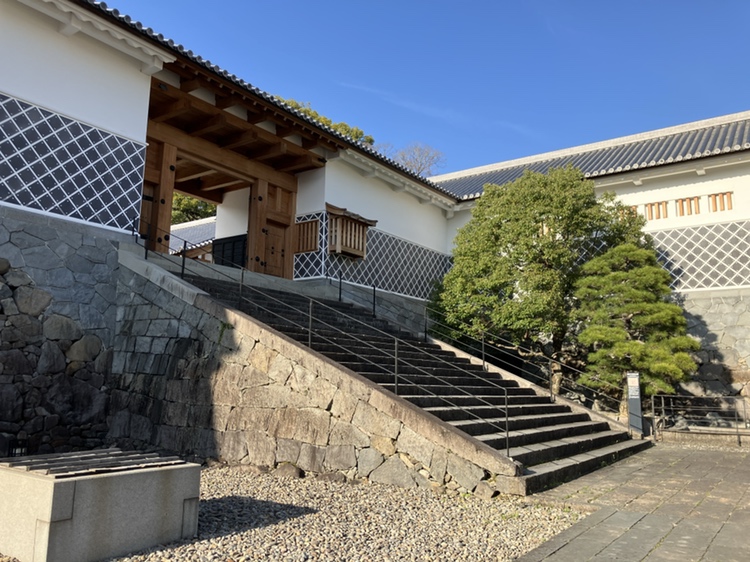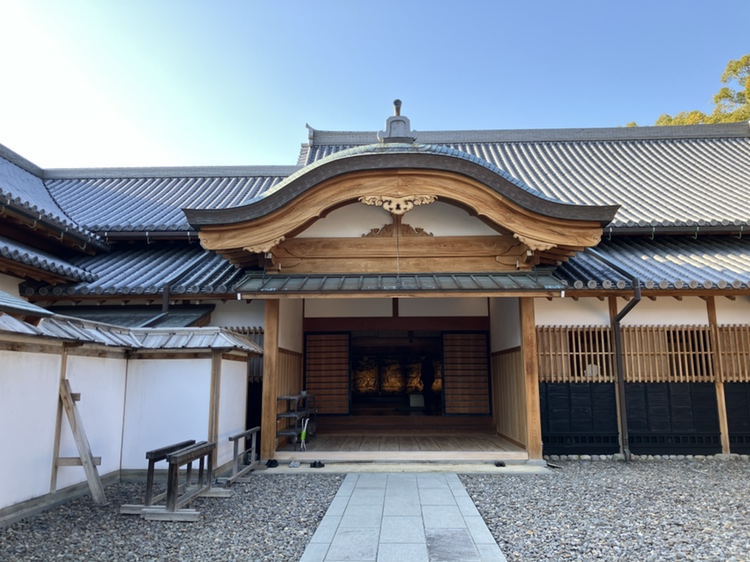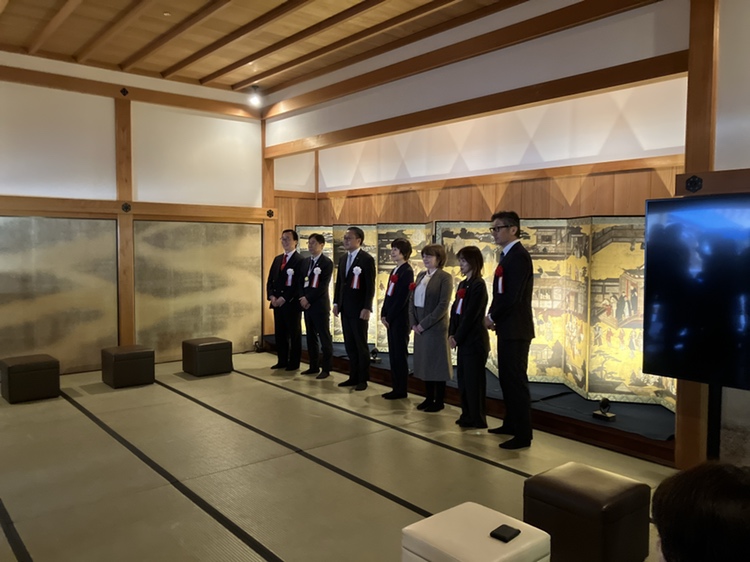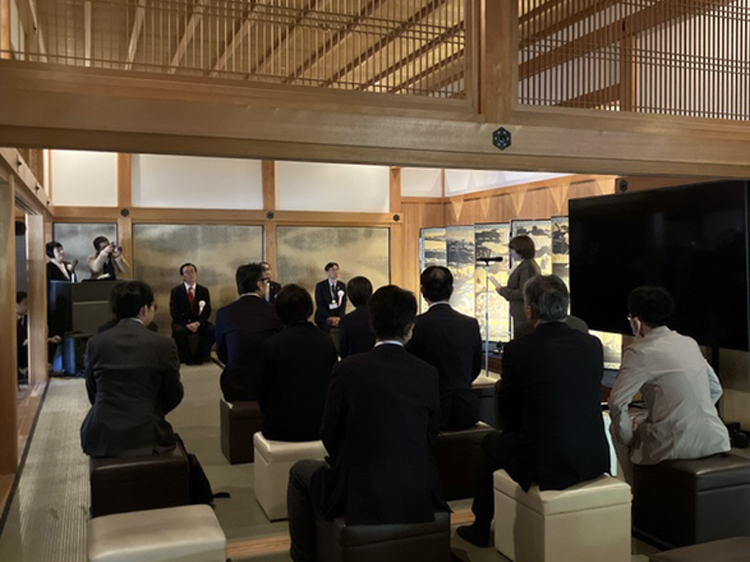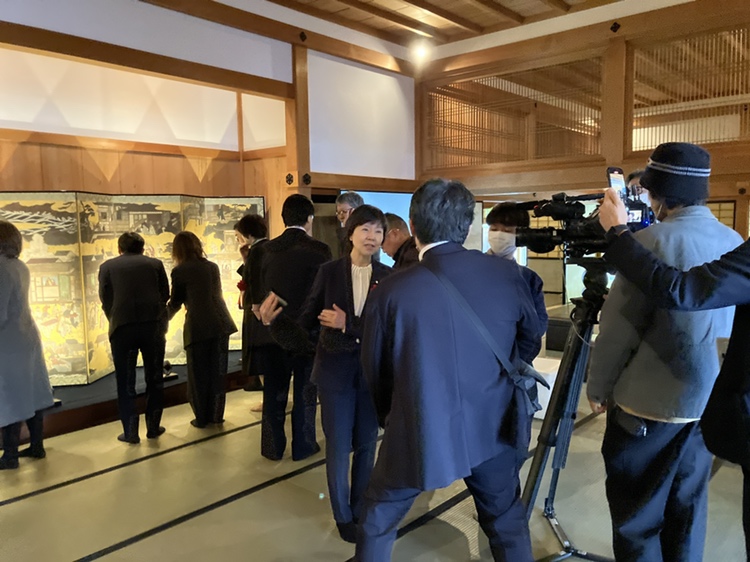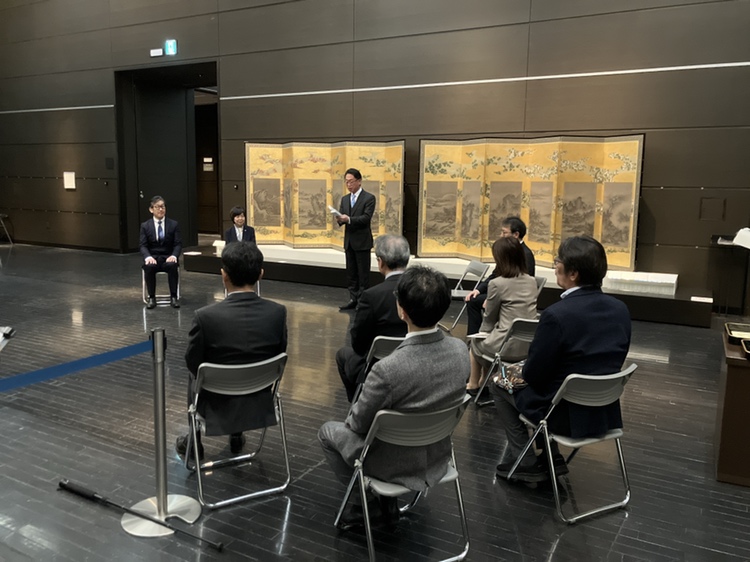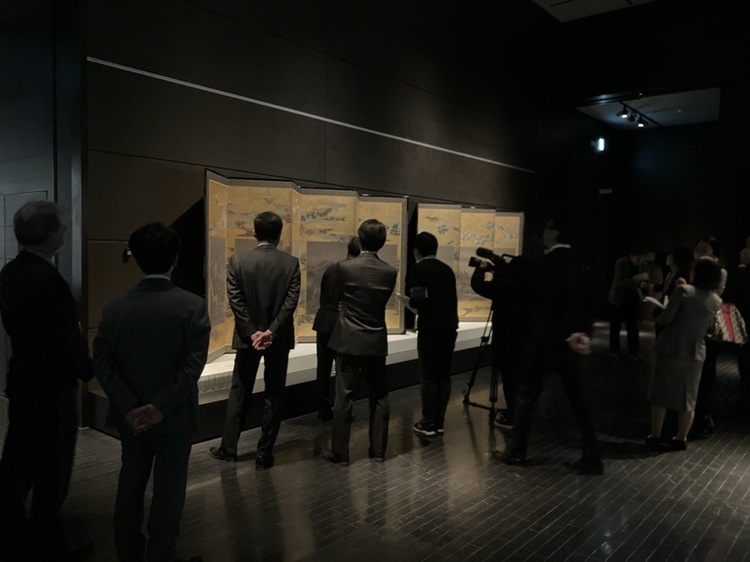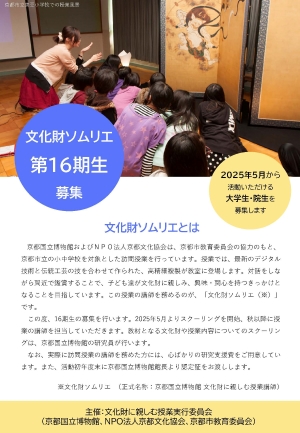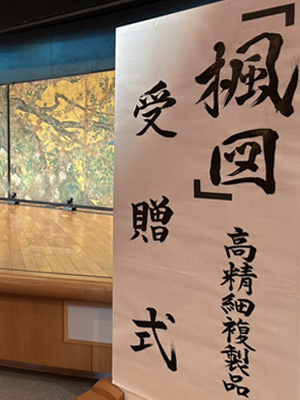
2025.09.05
Tsuzuri Project donated a high-resolution facsimile of a 16th-century Japanese National Treasure to the birthplace of the artist, supporting regional recovery from natural disasters
On September 5, 2025, the Tsuzuri Project (officially, the Cultural Heritage Inheritance Project), jointly promoted by Canon Inc. and the Kyoto Culture Association (NPO), donated a high-resolution facsimile of Maple by Hasegawa Tōhaku, designated as a National Treasure, to Nanao City in Ishikawa Prefecture, the birthplace of the artist.
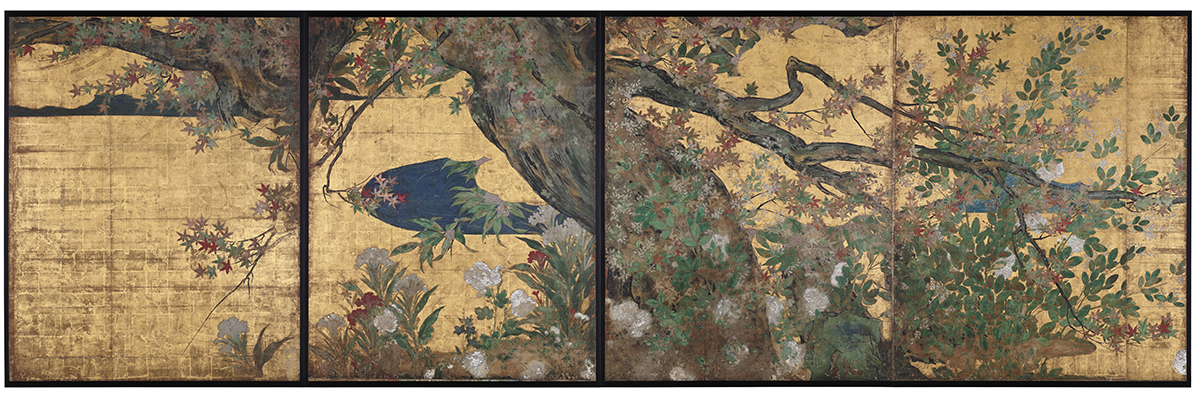
High-resolution facsimile of Maple (four-sided wall-mounted display)
This donation, which was made possible with the special cooperation of Chishakuin Temple—the head temple of the Chisan school of Shingon Buddhism in Kyoto and the owner of the original artwork—is intended to support the region’s recovery from damage caused by the Noto Peninsula earthquake in 2024.
Canon jointly reproduced the cultural property as part of Stage 17 of the Tsuzuri Project. Its EOS R5 full-frame mirrorless camera was used to capture images of the original work, after which Canon applied its proprietary color matching system and image processing. The facsimile was then output using large-format inkjet printers with 12-color pigment ink. Finally, Kyoto master craftsmen applied gold leaf to the facsimile and mounted it as wall-mounted panels (kabe-haritsuke), achieving an exceptionally faithful reproduction of the original work.
The reproduced artwork will be publicly exhibited1 at the Ishikawa Nanao Art Museum on September 20, and in the morning of September 21, 2025. Visitors will be able to view the work up close without a glass case and are welcome to take photographs. Additionally, the facsimile will be used in educational programs at local elementary and junior high schools as part of the Tokyo National Museum’s recovery support initiative titled “Hito Noto Art ” 2. These programs will include artwork appreciation classes featuring both the newly donated Maple and a previously produced facsimile of Hasegawa Tōhaku’s renowned Pine Trees. Through these activities, local students will gain opportunities to engage with the legacy of a native artist and deepen their understanding of Japanese cultural heritage. The piece will continue to be utilized in future exhibitions and educational programs at the Ishikawa Nanao Art Museum and schools throughout Nanao City.
About the artwork
Maple is a masterpiece of the Momoyama period, depicting a grand maple tree with vivid red and green leaves against a gold background. The work captures the opulence and lyricism of Japan’s autumnal landscape. Created by Hasegawa Tōhaku (1539–1610), a native of Noto (present-day Ishikawa Prefecture), the painting is considered one of the finest examples of kinpeki shouhekiga 3. It is designated as a national treasure alongside Cherry Blossoms, which was painted by his son Kyūzō.
About the 'Tsuzuri Project'
The Tsuzuri Project is a joint cultural support activity organized by Canon and Kyoto Culture Association (NPO) in 2007. Many of Japan’s precious historical and cultural assets have limited viewing opportunities, often because they have been moved overseas or are preserved in storage as designated national treasures. The project produces high-resolution facsimiles by combining Canon’s technical expertise in imaging, processing, and output with the master craftsmanship of traditional Kyoto artisans. These high-resolution facsimiles are donated to institutions with ties to cultural assets such as shrines, temples, local governments, and museums and are available for a variety of purposes including public display and tangible educational materials. So far, more than 60 high-resolution facsimiles of artwork from artists including Katsushika Hokusai, Tawaraya Sōtatsu, and Ogata Kōrin have been produced.
For more information, please visit the official Tsuzuri Project website
The Ceremony of the Donation
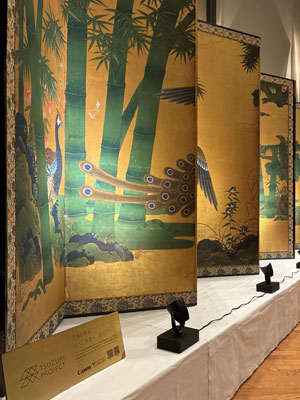
2025.06.25
Tsuzuri Project donates a high-resolution facsimile of 16th century artwork "Peafowl and Phoenixes" to a museum in Izumi, a city with strong ties to the attributed artist
On June 25, 2025, the Tsuzuri Project (officially, the Cultural Heritage Inheritance Project), jointly promoted by Canon Inc. and the Kyoto Culture Association (NPO), donated a high-resolution facsimile of "Peafowl and Phoenixes," a famous 16th century artwork attributed to Tosa Mitsuyoshi, to be displayed for a special public viewing at the Kuboso Memorial Museum of Arts, Izumi in Osaka, Japan. The original piece resides in the collection of the Cleveland Museum of Art in Cleveland, Ohio, U.S.A.
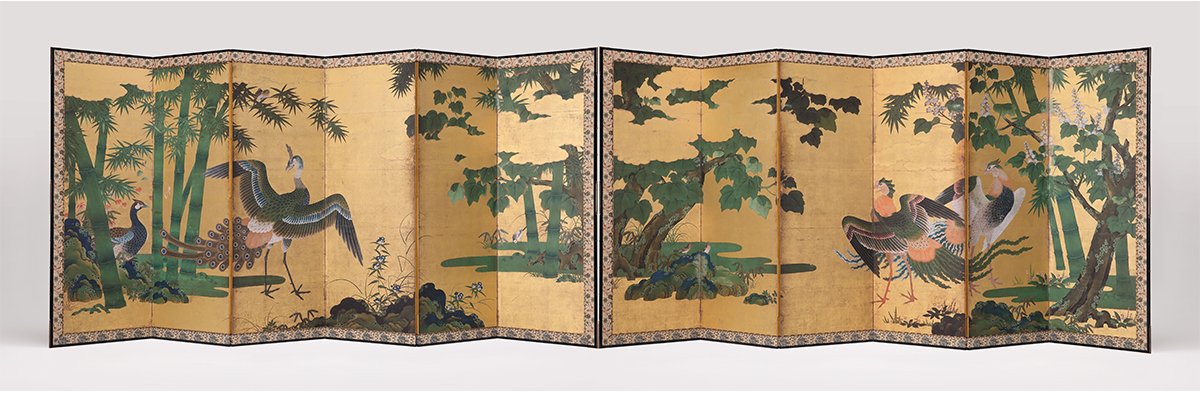
High-resolution facsimile of "Peafowl and Phoenixes"
The Cleveland Museum of Art, Leonard C. Hanna Jr. Fund 1986.2
"Peafowl and Phoenixes," is an elegant piece of art which was painted during the Momoyama period (1573-1615). It depicts a pair of male and female peafowl and a corresponding pair of phoenixes against a background of paulownia trees and bamboo, their gorgeous, painstakingly colored wings illuminated brilliantly amid the gold surroundings. The right-side folding screen features the phoenixes at the center, with spring flora such as horsetail shoots and violets drawn around their feet. On the left screen, the peafowl are surrounded by Japanese gentian and Chinese lantern plants, showing that the autumnal season is underway. This artwork, which was painted in exquisite detail with a subtle use of colors, is thought to be the work of Tosa Mitsuyoshi, a painter from the Tosa school who specialized in such detailed paintings.
"Peafowl and Phoenixes" is known as a valuable piece of artwork which conveys the history of Japanese art, combining both Yamato-e (Japanese-style paintings) and Kara-e (Chinese-style paintings) in a style similar to works produced by the Kano school. Tosa Mitsuyoshi was based in Izumi Province (modern-day southwestern Osaka Prefecture), the location of the Imperial Court painting bureau which managed Imperial Court painters, and is said to have been connected to townspeople such as merchants and cultural figures. Therefore, in a sense, the donation of this high-resolution facsimile might be considered its “return home” to Izumi.
Canon jointly reproduced the cultural property as part of the Stage 17 of the Tsuzuri Project. Its EOS R5 full-frame mirrorless camera was used to capture images of the original work, after which Canon applied its proprietary color matching system and image processing. The facsimile was then output using large-format inkjet printers with 12-color pigment ink. Finally, expert Kyoto craftsmen applied gold to the facsimile and mounted it on folding screen frames, completing an extremely accurate reproduction of the original work.
The donated work will be displayed* for a special public viewing from Thursday, June 26, 2025 to Sunday, March 22, 2026 in the lounge of the main building of the Kuboso Memorial Museum of Arts, Izumi, which houses many masterpieces of Oriental antiquity, national treasures and important cultural properties and is known as a regional cultural hub. At the exhibition, visitors will not only be allowed to take photographs but also view the artwork up close without a glass case. This will allow them to fully appreciate the unique impact and beauty of the full-scale model which faithfully reproduces the delicate color tones and decorative expressions, including the gold used for the phoenix and peafowl feathers. The work will later become a permanent display at the museum. As the creation of a painter who has a strong connection to the region, it will also be used for cultural events organized by Izumi City and events held in cooperation with local communities.
Kuboso Memorial Museum of Arts, Izumi
About the 'Tsuzuri Project'
The Tsuzuri Project is a joint cultural support activity organized by Canon and Kyoto Culture Association (NPO) in 2007. Many of Japan’s precious historical and cultural assets have limited viewing opportunities, often because they have been moved overseas or are preserved in storage as designated national treasures. The project produces high-resolution facsimiles by combining Canon’s technical expertise in imaging, processing, and output with the master craftsmanship of traditional Kyoto artisans. These high-resolution facsimiles are donated to institutions with ties to cultural assets such as shrines, temples, local governments, and museums and are available for a variety of purposes including public display and tangible educational materials. So far, more than 60 high-resolution facsimiles of artwork from artists including Katsushika Hokusai, Tawaraya Sōtatsu, and Ogata Kōrin have been produced.
For more information, please visit the official Tsuzuri Project website
The Ceremony of the Donation
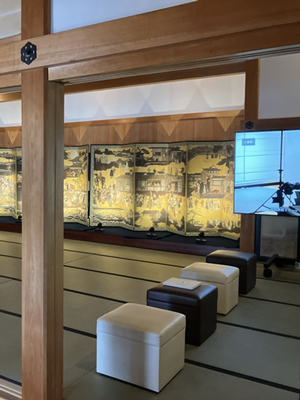
2025.03.07
Tsuzuri Project donates to Nagasaki Prefecture a high-resolution facsimile of 17th century artwork, "Arrival of the Southern Barbarians" housed in the Cleveland Museum of Art
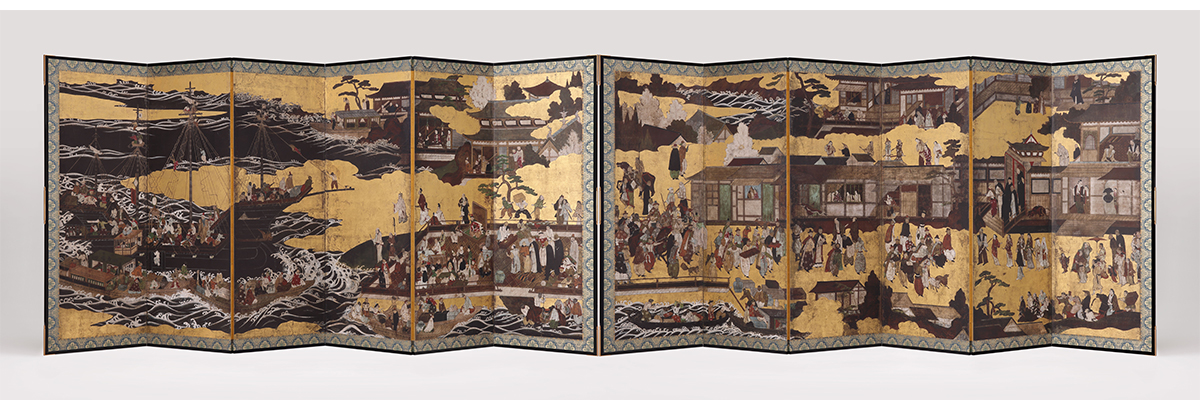
High-resolution facsimile of “Arrival of the Southern Barbarians”
The Cleveland Museum of Art, Leonard C. Hanna Jr. Fund 1960.193
The artwork is a pair of six-panel folding screens which depict trading with foreigners, mainly Europeans, who arrived in Japan during the Azuchi-Momoyama period in the early 17th century. The left screen shows the arrival of a foreign ship and various trade goods, while the right screen shows the procession of foreigners who have landed and a group of Japanese people awaiting them with curious expressions on their faces. Such folding screens, collectively referred to as “Nanban (Southern barbarian) screens,” were created in Japan from the late 16th to the early 17th century, with over 100 pieces believed to still exist in Japan and overseas. Among them, this particular artwork is valued for its use of elegant and decorative expressions, including the vivid illustration of over 300 diverse figures and the dynamic movement of waves surrounding the ship.
“Arrival of the Southern Barbarians” was originally owned by Nagami Tokutaro, the sixth-generation head of one of the wealthiest merchant families in Nagasaki which had existed since the Edo Period. This piece, which was said to have initially sparked Nagami’s interest in Nanban screens, was one of the most cherished in his collection. Through a series of events, it later ended up in the collection of the Cleveland Museum of Art, where it currently resides.
Canon jointly reproduced the cultural property as part of the Stage 17 of the Tsuzuri Project. Its EOS R5 full-frame mirrorless camera was used to capture images of the original work, after which Canon applied its proprietary color matching system and image processing. The facsimile was then output using large-format inkjet printers with 12-color pigment ink. Finally, expert Kyoto craftsmen applied gold to the facsimile and mounted it on folding screen frames, completing an extremely accurate reproduction of the original work.
Now, through the donation of a high-resolution facsimile, “Arrival of the Southern Barbarians” has returned to Nagasaki, the birthplace of Nagami and the former center of the “Nanban trade” involving trade with countries such as Spain and Portugal.
The donated folding screens will reside at the Nagasaki Museum of History and Culture, which houses historical materials related to international exchanges from the Edo Period to the earlier 19th century and a large number of works collected by Nagami Tokutaro, who devoted himself to the collection of Nanban art and related research. They will then be displayed* in a zone within the museum’s permanent exhibition area for showcasing the history of communication between Japan and overseas, and are also scheduled to be used in special exhibitions at various locations within the prefecture or in educational activities including experiential programs in collaboration with local communities. To commemorate the donation, from March 8th to March 16th, the screens will be displayed at the entrance hall of the museum as a special exhibition at which visitors will be permitted to take pictures and observe them up-close without a glass case.
Nagasaki Museum of History and Culture
Admission to the entrance hall is free. However, a separate fee is required to view the permanent exhibitions. For information about museum opening hours and display locations, please visit the official Nagasaki Museum of History and Culture.
About the Tsuzuri Project
The Tsuzuri Project is a joint cultural support activity organized by Canon and Kyoto Culture Association (NPO) in 2007. Many of Japan’s precious historical and cultural assets have limited viewing opportunities, often because they have been moved overseas or are preserved in storage as designated national treasures. The project produces high-resolution facsimiles by combining Canon’s technical expertise in imaging, processing, and output with the master craftsmanship of traditional Kyoto artisans. These high-resolution facsimiles are donated to institutions with ties to cultural assets such as shrines, temples, local governments, and museums and are available for a variety of purposes including public display and tangible educational materials. So far, more than 60 high-resolution facsimiles of artwork from artists including Katsushika Hokusai, Tawaraya Sōtatsu, and Ogata Kōrin have been produced.
The Ceremony of the Donation
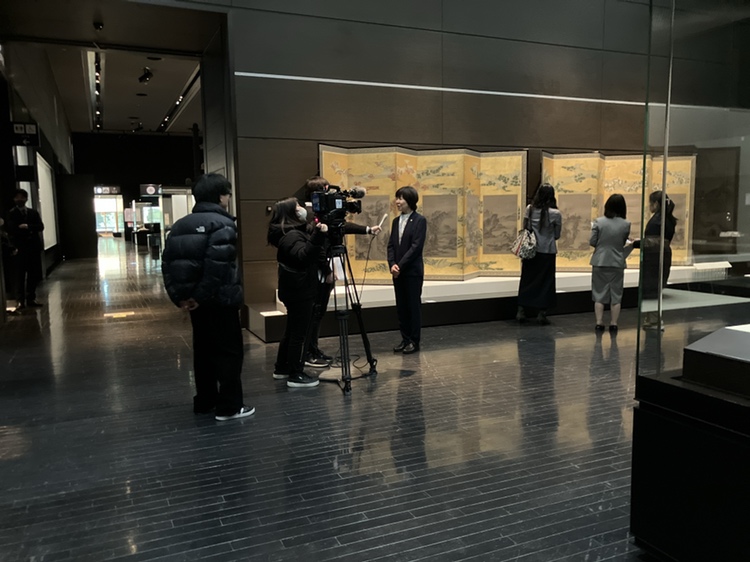
2025.02.04
Tsuzuri Project donates to Kyushu National Museum (one of the National Institutes for Cultural Heritage) a high-resolution facsimile of a Kano School's 16th century masterpiece, "Landscapes, flowers, and trees of the four seasons"
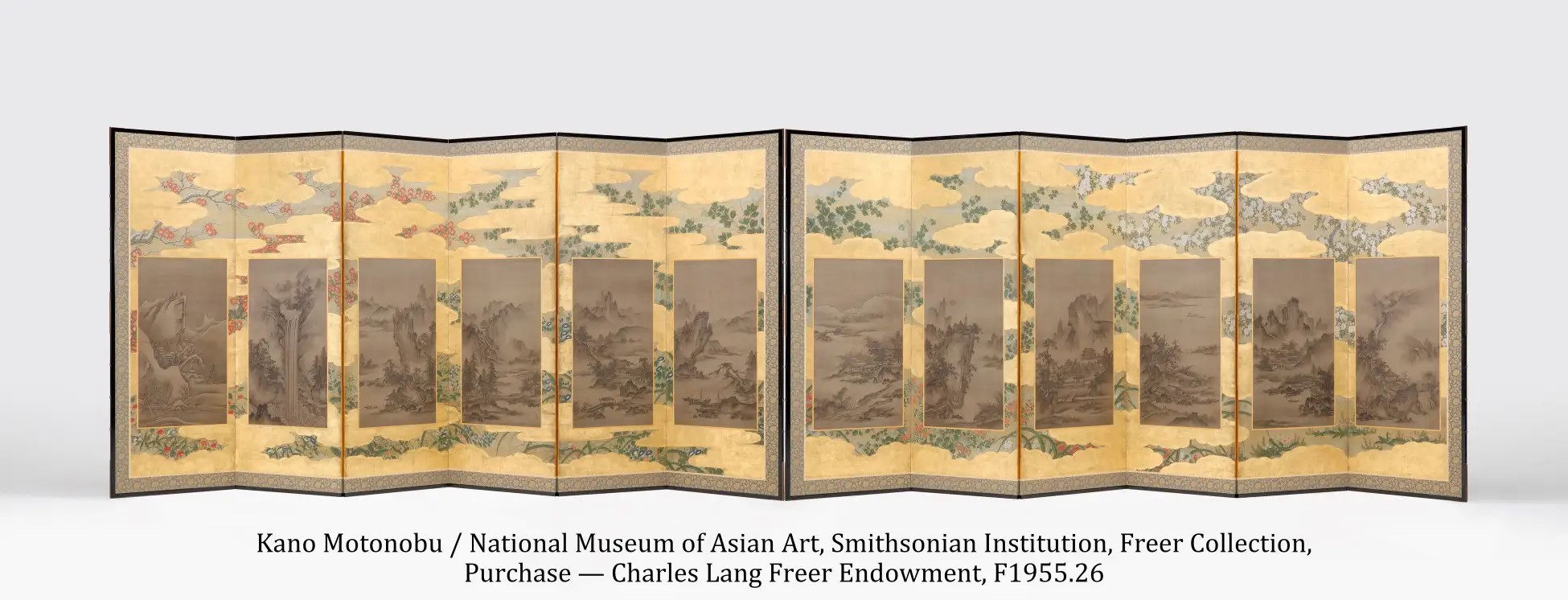
High-Resolution facsimiles of 'Landscapes, flowers, and trees of the four seasons'
Canon Inc. (“Canon”) and the Kyoto Culture Association (NPO) have donated a high-resolution facsimile of 'Landscapes, Flowers, and trees of the four seasons' by Kano Motonobu from the Smithsonian’s National Museum of Asian Art, USA. This facsimile was produced as part of the 16th phase of the 'Tsuzuri Project' (officially called the 'Future Succession Project of Cultural Properties').
The high-resolution facsimile has been donated to the National Institutes for Cultural Heritage and Kyushu National Museum (Dazaifu City, Fukuoka Prefecture) and will be on display at the museum until Sunday, March 16, 2025.
A high-resolution facsimile of 'Landscapes, flowers, and trees of the four seasons' created through a fusion of Canon's technology and traditional Kyoto craftsmanship.
'Landscapes, flowers, and trees of the four seasons' is considered a reproduction of the custom of hanging scrolls on ornate folding screens, a practice that became popular in the late Muromachi period (1333–1573). The silk painting features Chinese-style ink-wash landscapes, while the gold-leaf background is adorned with vivid Japanese-style flowers.
The artist, Kano Motonobu, was the son of Masanobu, the founder of the Kano school. He established the so-called "Japanese-Chinese fusion" style by incorporating the Yamato-e techniques, a specialty of the Tosa school, into Kanga (Chinese-style ink painting), which formed the foundation of the Kano school. His innovations played a decisive role in ensuring the school's prosperity for 400 years.
The original work is housed in the Smithsonian’s National Museum of Asian Art in the U.S., where, according to the will of its founder, its collection is not allowed to leave the museum. As a result, the work can only be viewed by visiting the museum in person.
The production of a high-resolution facsimile has enabled this masterpiece of Japanese painting to symbolically “return” to Japan. This work, which exemplifies the fusion of Japanese and Chinese painting styles, has been donated to the Kyushu National Museum, which will celebrate its 20th anniversary in 2025. The donation aligns with the museum’s concept of “understanding the formation of Japanese culture from an Asian historical perspective.”
The original cultural property was photographed using Canon’s EOS R5 full-frame mirrorless camera. The images were then processed with a proprietary color-matching system and printed on a large-format inkjet printer equipped with 12-color pigment inks.
Traditional craftsmen in Kyoto further enhanced the reproduction by applying gold leaf and other decorative elements before assembling it into a folding screen, ensuring the most faithful recreation of the original cultural property.
Exhibition of the Donated Work at the Kyushu National Museum
The donated work will be on display in the Cultural Exchange Exhibition Room (Permanent Exhibition) of the Kyushu National Museum until Sunday, March 16, 2025.
This exhibition features not only folding screen paintings by Kano Eitoku, a master of the Kano school, but also exquisite lacquerware, including maki-e inkstone boxes. Visitors can appreciate outstanding examples of Japanese art that emerged and evolved through influences from Chinese culture.
Additionally, the donated work offers a unique viewing experience possible only with high-resolution facsimiles. Visitors can enjoy photographing the work and viewing it up close without the obstruction of glass cases.
Kyushu National Museum Website
About the 'Tsuzuri Project'
The Tsuzuri Project is a cultural support initiative jointly promoted by Canon Inc. and the Kyoto Culture Association (a Non-Profit Organization) since 2007. Many of Japan's precious cultural properties, including those that were lost to foreign countries over the course of history or are carefully preserved as national treasures, have limited opportunities for public viewing. The Tsuzuri Project combines Canon's imaging technologies—from input and image processing to output—with the expertise of traditional Kyoto craftsmen to create high-resolution facsimiles that faithfully reproduce the original cultural properties. These high-resolution facsimiles are donated to temples, shrines, local governments, museums, and other institutions associated with cultural properties, and are used in a variety of settings, including public exhibitions at the donation sites and in school education. To date, more than 60 high-resolution facsimiles have been produced, including works by Katsushika Hokusai, Tawaraya Sotatsu, and Ogata Korin.
The Ceremony of the Donation
2025.02.04
Cultural Property Sommelier wanted!
<Purpose>
Kyoto National Museum and Kyoto Culture Association launched the “Learning support program for elementary and junior high school students: using high-resolution facsimiles of cultural properties as leaning materials” to offer children opportunities to be more familiar with Japanese cultural properties and to raise their interests on those assets.
Now we are seeking 10 new students who learn art history at university and graduate schools and who satisfy requirement for Cultural Property Sommelier.
<Detail>
We seek university or graduate students who are able to participate in the project from next spring. The schooling will start in May 2025, and teaching at elementary and junior high schools will start in June 2025. There will be some gratuity for activities.
<Application requirements>
- The requirements for the application are as follows:
- ・Students of university or graduate schools in Kyoto, who also will be enrolled next year
- ・Who has or had taken Japanese Modern Art History class
- ・Whose university or graduate schools must be campus members of Kyoto National Museum
- ・Who will be able to participate schoolings twice or three times a month (Wednesday)
<Number of the sommelier>
About 10 people
<Application period>
Starting from Early February 2025 to April 17, 2025 until 5:00 PM.
Closed the books.
<Schooling>
- Two-hour session for twice or three times a month (Wednesday)
- Place: Kyoto National Museum (except the second schooling)
- Teacher: an associate fellow of Kyoto National Museum
- Content: lecture about cultural properties; teaching methods etc.
<Inquiry>
Please contact Ohkubo, Kenshi at 
<Organizer>
Kyoto National Museum, NPO Kyoto Culture Association
Supported by: Kyoto City Board of Education





